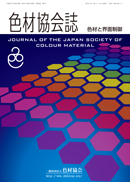
- |<
- <
- 1
- >
- >|
-
~Color Analysis of Ukiyo-e and Illuminated Manuscripts by X-ray Fluorescence and Raman Spectroscopy~Makoto OISHI2022Volume 95Issue 5 Pages 107-114
Published: May 20, 2022
Released on J-STAGE: May 28, 2022
JOURNAL RESTRICTED ACCESSUkiyo-e prints produced in the Edo period and illuminated manuscripts painted in medieval Europe use a variety of colorful pigments, dyes, and other color materials. This paper introduces the non-destructive and non-contact analysis of these pigments and other color materials by X-ray fluorescence analysis and Raman spectroscopic analysis, including the identification of the color materials used and the findings obtained.
View full abstractDownload PDF (2841K)
-
Atsushi TOMOTAKE2022Volume 95Issue 5 Pages 115-121
Published: May 20, 2022
Released on J-STAGE: May 28, 2022
JOURNAL RESTRICTED ACCESSIn recent years, the development of large commercial inkjet printers and printers for printing on fabric and film has become more and more active. To produce high quality images on media in these fields, various properties of inks have been required. Inks are made up of chemical substances and there are various types of inks depending on the purpose of image formation. The characteristics of these inks vary greatly.
In this lecture, the classification and characteristics of inks used in inkjet technology, their constituent materials and design, and various inks are explained. The latest technology trends are also introduced.
View full abstractDownload PDF (1086K)
-
Yuuka KOKUBO, Misa OGAWA, Tatsuo FUJII, Toshinori OKURA, Hideki HASHIM ...2022Volume 95Issue 5 Pages 122-127
Published: May 20, 2022
Released on J-STAGE: May 28, 2022
JOURNAL RESTRICTED ACCESSThe effect of the microstructure on the color tone of the heat-treated red paint for ceramics, which is obtained by mixing hematite with multicomponent alkali borosilicate lead-free frit, was investigated. On the basis of X-ray diffractometry, microscopy, energy-dispersive X-ray spectroscopy, and Mössbauer spectroscopy, the color changed depending on the firing temperature, and at the same time, a part of hematite dissolved as tetrahedrally-coordinated Fe3+ in the glass matrix and the particle size of hematite increased via Ostwald ripening. The sample surface smoothening and the decrease in the number of hematite particles due to the dissolution of hematite should improve the particle dispersibility, leading to the chroma improvement in the low temperature region, whereas the hematite particle growth and excessive dissolution of hematite should decrease the chroma in the high temperature region. The coloration mechanism changed from light absorption of hematite particles to light absorption of tetrahedrally-coordinated Fe3+ in the glass matrix in the high temperature region where hematite is completely dissolved and ionized.
View full abstractDownload PDF (1643K)
-
Kazufumi NAGAI2022Volume 95Issue 5 Pages 128-137
Published: May 20, 2022
Released on J-STAGE: May 28, 2022
JOURNAL RESTRICTED ACCESSIn this era of VUCA, the management environment is changing rapidly, and “design management” is now attracting attention. Design management is a management approach that applies the inherent ideas and methods of design to the management of a business, focusing on people and creating value. We would like to summarise what “design management” is, what it can achieve, who is responsible for it, and the challenges it faces in spreading.
View full abstractDownload PDF (1180K)
-
Hiromasa NISHIKIORI2022Volume 95Issue 5 Pages 138-143
Published: May 20, 2022
Released on J-STAGE: May 28, 2022
JOURNAL RESTRICTED ACCESSThe photofunctional solid materials can be prepared by incorporating the photofunctional organic dye molecules into the solid media. The spectroscopic properties of the organic-inorganic composite materials depend on the chemical environment of the dye molecules. The required functions should be obtained by controlling the dye properties after consideration of the interaction between the dye molecule and medium. The spectroscopic properties of the dye molecules in the inorganic media are explained with the examples of utilizing the photochromic, sensitizing, and emission properties of the dyes originating from their molecular structures and electronic states. The spectroscopic sensing using the dye molecule is also reported.
View full abstractDownload PDF (751K)
- |<
- <
- 1
- >
- >|